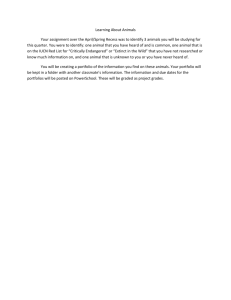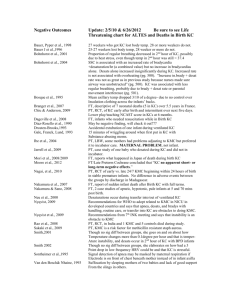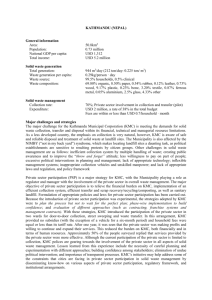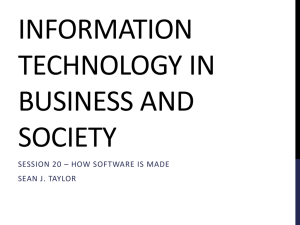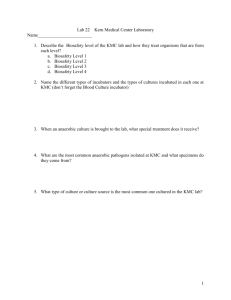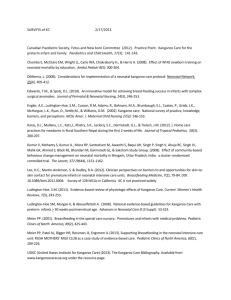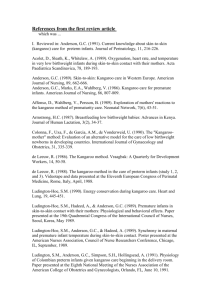Diapositiva 1 - Fundación Canguro
advertisement
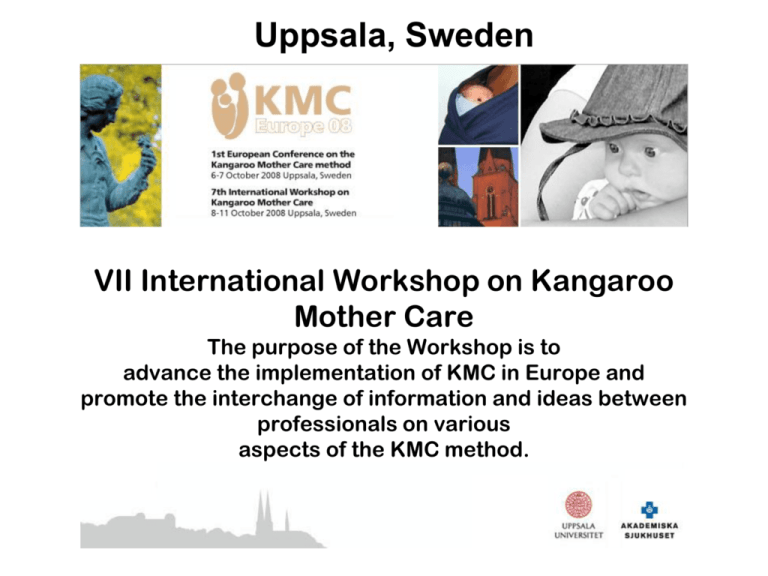
Uppsala, Sweden VII International Workshop on Kangaroo Mother Care The purpose of the Workshop is to advance the implementation of KMC in Europe and promote the interchange of information and ideas between professionals on various aspects of the KMC method. October 8th Oral Presentations Abstract/Conclusions/Summary SWEDISH LEGACIES AND MECHANISMS RELEVANT TO KANGAROO MOTHER CARE (KMC) Gene Cranston Anderson, RN, Professor Proffesor Anderson quotes some studies aiming to justify the hypothesis that intermittent hard crying postbirth interferes with PFOanatomical closure and appropriately programmed stress responsivity. College of Nursing, University of Florida, Gainesville Summary MORBI-MORTALITY OF THE LOW BIRTH WEIGHT INFANT (LBWI) AND KANGAROO MOTHER CARE: THE COLOMBIAN EXPERIENCE Nathalie Charpak, MD PhD Kangaroo Foundation, Bogota, Colombia. Summary Evaluation of the efficacy and safety of KMC as applied in Colombia through scientific research: KMC for the stable infant. Evaluation of the performance of a KMC Program in terms of selected health outcomes achieved and compliance with evidence-based processes. Close monitoring of compliance with evidence-based procedures, and frequent feed back may partially explain the success of the program. … October 8th Oral Presentations Abstract/Conclusions/Summary KANGAROO MOTHER CARE (KMC) IMPLEMENTATION IN NIGERIA: THE STORY SO FAR Ochiawunma Ibe, MD, Senior Manager Orphans and Vulnerable Children USAID Nigeria Key Recommendations: 1. Training of health care professionals at all levels provides an impetus for KMC to be fully implemented once introduced in any setting. 2. Adequate policy guidance will facilitate implementation. 3. Initiation and sustenance of a pilot centre for training and demonstration purposes is required Maitama Abuja, FCT Nigeria Summary GROWTH AND DEVELOPMENT IN KMC-NICU GRADUATES Rekha H Udani, MD, Professor, Head Neonatology; Ashish Satpathy, Ruchi N Nanavati Seth G S Medical College & KEM Hospital, D Y Patil Medical college & Hospital, Navi Mumbai, India Summary Global experience & randomized control trials have shown the benefits of Kangaroo Mother Care (KMC) & it can be applied everywhere including peripheral community hospitals. The evidence related to growth & development in KMC recipient is limited and so the present prospective cohort follow up study was undertaken. Conclusions: Kangaroo Mother Care promotes appropriate growth and development and promotes breastfeeding in NICU Graduates ≤1800g. … October 8th Oral Presentations Abstract/Conclusions/Summary VALIDATION OF A PREDICTION RULE FOR IDENTIFYING PRETERM INFANTS UNDER KANGAROO MOTHER CARE (KMC) WHO NEED SUPLEMENTATION OF BREASTFEEDING Juan Gabriel Ruiz-Peláez, MD, MMedSci1, Natalie Charpak MD2 Gloria Sánchez MD MSc (Cand)2 1Departments of Clinical Epidemiology & Biostatistics and Pediatrics, School of Medicine, Pontificia Universidad Javeriana, and 2 Fundación Canguro,Bogotá, Colombia. Exclusive breastfeeding for premature infants is a controversial and very important issue particularly in developing countries, where supplementing or fortifying breast milk implies manipulation of breast milk, with increased risk of microbiological contamination; besides, delivering fortifiers for breast milk is seldom affordable and practical. Our findings constitute a way of rationalizing the use of preterm Formula, as the almost only available resource for supplementation of direct breast feeding in ambulatory patients in many developing countries. After local validation at each interested place, the prediction rule can be useful in implementing this type of feeding policies, in similar settings. EFFECT OF KANGAROO POSITION ON PAIN IN PRETERM NEONATES Suman Rao, MD, Associate Professor of Neonatology Dept. of Pediatrics, St. John’s Medical College Hospital, Bangalore Summary Preterm neonates undergo many invasive procedures without benefit of analgesia. Preventing or minimizing pain is of paramount importance. Subjects and Interventions: Stable preterm neonates were enrolled in the study after written parental informed consent. During Kangaroo care, the Prectl and Beintema behavioral state, the maximum heart rate and the minimum saturations in the 15 sec prior to heel lancing were noted. The neonates were subjected to heel lancing for routine random glucose monitoring while in kangaroo care after half an hour. Summary October 8th Oral Presentations Abstract/Conclusions/Summary WHO KMC GUIDELINES Jelka Zupan, MD. Intervention about the need to reformulate and update the WHO KMC Guidelines. EVALUATION OF CONTINUOUS KMC IN A HIGH TECH NICU Ylva Thernström Blomqvist, RN, PhD Student, Kerstin Hedberg Nyqvist, RN, Associate Professor of Pediatric Nursing Despite the evidence of positive effects of KMC, and the fact that Swedish parents are guaranteed temporary parental benefit when the newborn infant is sick and/or born preterm, KMC is still underused in Sweden. One possible explanation for this is a belief among hospital staff that mothers in Sweden would not accept this model of carebut the study shows, mothers accepted KMC model very well, on the condition that they were given the help and support they wanted. This study and existing evidence support the view that parents’ chest should be considered the optimal place for provision of infant care, and that care routines at neonatal units should be changed accordingly Neonatal unit 95 F, University Hospital, Uppsala, and Dept. of Women’s and Children’s Health, Uppsala University, Uppsala, Sweden Summary Thursday October 9th Oral Presentations Abstract/Conclusions/Summary BIRTH SKIN TO SKIN CARE: HOW MUCH IS ENOUGH? Salahuddin Ahmed, MD Johns Hopkins University, Based in Bangladesh, Dept. of International Health, Baluchar Bangladesh We adapted KMC for community-based birth KMC (CKMC) in rural Bangladesh where home birth, low birth weight and newborn mortality (NMR) are high. As Anderson et al (2003) found, Skin-to-Skin is implemented less than recommended. Frequency and duration of birth STS may be sufficient to impart survival benefits, while others find constancy critical to thermal regulation. Additional review is still needed. Summary MONITORING TIMING, DURATION AND QUALITY OF EARLY SKIN-TO-SKIN CONTACT IN THE HOSPITAL SETTING Laura N. Haiek1, Lydia Rochealeau2 1,2 Direction de santé publique de la Montérégie,1Institut national de santé publique du Québec, 1Department of Family Medicine, McGill University Summary In order to adequately support hospitals in implementing skin-to-skin contact (SSC) after delivery, Québec’s Montérégie regional public health authority has monitored this best practice in its 9 maternity units. In conclusion, Monitoring data helps individual hospitals revise practices to comply with SCC recommendations. It also allows health authorities to follow the evolution of SCC implementation in response to regional and local actions. Thursday October 9th Oral Presentations Abstract/Conclusions/Summary KANGAROO CARE (SKIN CONTACT) REDUCES CRYING RESPONSE TO PAIN IN PRETERM INFANTS Raouth R. Kostandy1, Susan M. Ludington-Hoe2 1 College of Nursing, University of Akron, Akron, Ohio; 2 Bolton School of Nursing, Case Western Reserve University, Cleveland, Ohio Summary Crying commonly occurs in response to heel stick and adversely affects the infant’s physiologic stability. Kangaroo Care (KC) reduces pain and may reduce crying in response to pain. The purpose of the pilot was to test KC’s effect on the preterm infant’s audible and inaudible crying during heel-stick. Because Kangaroo Care reduced crying in response to heel stick in medically stable preterm infants, a definitive study is next needed prior to making recommendations EXTREMELY PREMATURE INFANTS’ REACTIONS TO SKIN-TO-SKIN CONTACT Ragnhild Maastrup, RN Knowledge Centre for Breastfeeding Infants with Special Needs, Rigshospitale, Copenhagen, Denmark The benefits of skin-to-skin contact (sts-contact) for extremely premature infants (<28 weeks gestational age) are not as well supported as for other premature infants. This ongoing study will try to add more evidence to the subject. There are no results yet. Summary Thursday October 9th Oral Presentations Abstract/Conclusions/Summary EARLIER IS BETTER? : RANDOMIZED CONTROLLED TRIAL (RCT) OF KANGAROO MOTHER CARE (KMC) IN MADAGASCAR S. Nagai1,2, D. Andrianarimanana2, N. Rabesabdratana2, R. Mori1,3, N. Yonemoto3, A. Ramarijaona2, M. E. Razafanomezanjanahary2, T.Nakayama1 Kyoto University, To examine effectiveness of KMC start as soon as possible within 24 hours after birth for the LBW infants and their mothers. To date there are 54 children included in the study with a predicted 100 total by October, 2008, which will provide more conclusive results. The conclusions will be presentable upon the inclusion of up to 100 participants as outlined in the results. School of Public Health, Department of Health Informatics, Japan 1, University hospital of Mahajanga, Madagascar 2, Osaka Medical Center and Research Institute for Maternaland Child Health, Japan 3. Summary IMPLEMENTING BIRTH KANGAROO CARE FOR FULLTERM INFANTS: A TRANSLATIONAL RESEARCH PROJECT IN THE U.S. Barbara Morrison, PhD, CNM, FNP; Susan Ludington-Hoe, PhD, CNM, FAAN Case Western Reserve University, Cleveland, Ohio, Frances Payne Bolton School of Nursing, Cleveland, Ohio, USA Summary In 1991, the WHO launched the Baby-Friendly Hospital Initiative and in 1997 Baby-Friendly USA was formed to assist hospital in becoming baby friendly. But hospitals in the U.S. have been slow to become babyfriendly, only 56 hospitals in 2007. Maternity nurses (labor and delivery, postpartum, nursery and home care nurses and lactation consultants) are leading the change in birth practices so routine care includes skin-to-skin contact starting immediately after birth. But there is much resistance and many barriers to changing practice. Initial results of the implementation process including staff and patient satisfaction and breastfeeding outcomes over the first month will be presented. Friday October 10th Oral Presentations Abstract/Conclusions/Summary EVALUATION OF KANGAROO MOTHER CARE IN MALAWI Anne-Marie Bergh1, Reuben Ligowe2, Evelyn Zimba2, Elise van Rooyen1, Joy Lawn3, George Chiundu2 1 MRC Unit for Maternal and Infant Health Kangaroo mother care (KMC) was introduced in Malawi in 1999 and has since been extended to a number of hospitals. A retrospective assessment of KMC was conducted with a view to making recommendations for scaling up KMC to all district hospitals. There are high levels of awareness of the benefits of KMC in Malawi and strong support from Ministry of Health level. It is possible to design and implement a scale-up programme for Malawi to involve all district hospitals. Close monitoring of practices and quality is advised. KMC IN THE COMMUNITIES OF KANCHANPUR DISTRICT OF NEPAL Neena Khadka1, Meena Sharma2, Chandra Rai3, Judith Moore4 Save the In Nepal, around 20% of babies are low birth weight (LBW) and 80% percent are born at home making it necessary to explore the feasibility of initiating KMC at this level. Female Community Health Volunteers (FCHVs) were trained to weigh, identify and support families to practice KMC at home. KMC was acceptable and feasible at the household level with over 50% mothers of LBW babies practicing KMC. FCHVs scored over 80% when assessed in 5 key KMC skills. The major challenge was peripheral health facilities readiness to LBW referred to them. Care Strategies and University of Pretoria; 2 Save the Children Malawi Country Office; 3 Save the Children/Saving Newborn Lives Summary Children US 1, Save the Children US 2, Save the Children US 3. JHPIEGO Summary Friday October 10th Oral Presentations Abstract/Conclusions/Summary KANGAROO MOTHER CARE IN LOW BIRTH WEIGHT BABIES – SAFETY, FEASIBILITY AND ACCEPTABILITY Maria UP (Sr. Lias), Suman Rao PN, Swarnarekha Bhat To compare the physiological parameters (heart rate, respiratory rate and temperature ) during KMC and conventional care in LBW babies KMC had a beneficial effect in temperature regulation in LBW infants, especially in larger babies cared for in the postnatal ward with the mother. It is very feasible and safe to practice KMC. Mothers gained confidence in handling and taking care of the babies at home. PROVIDING COMMUNITY-BASED KMC: RECOMMENDATIONS FROM A RECENT CONSULTATIVE MEETING Stephen Wall and Joseph de Graft Johnson Save the Children’s ACCESS & Kangaroo Mother Care is an effective intervention for managing low birth weight (LBW) newborns in facilities, but less is known regarding the feasibility and effectiveness of community-based Kangaroo Mother Care (c-KMC). A recent consultative meeting produced recommendations for programs to move forward to include c-KMC. Providing c-KME in programs through integration with ENC requires local understanding of optimal methods, and carefully designed monitoring/evaluation of use and effectiveness. Formative research, integration with ENC, linkages with the health system for referral, and robust monitoring and evaluation are all essential elements. Division of Neonatology, Dept. of Pediatrics, St. John’s Medical College Hospital, Koramangala, Bangalore, India Summary Saving Newborn Lives (US) Summary Friday October 10th Oral Presentations Abstract/Conclusions/Summary INTERACTION ANALYSIS AND VIDEO ETHNOGRAPHY TO IMPLEMENTIMMEDIATE UNINTERRUPTED SKIN-TO-SKIN: A CASE STUDY Brimdyr Kajsa 1, Cadwell Karin 1, Widström AnnMarie 2 , Svensson Kristin 2, Azza Abul-Fadl 3, Abla el Alfy 3, Cynthia Turner-Maffei 1. The Healty Children Project, Inc., 2 Karolinska Institute, 3 The Egyptian Lactation Consultant Association and the Centre of Social & Preventive Medicine in Cairo University. Summary In their quest to revitalize the updated BFHI, Egyptian Maternal and Child Health Departments of the Ministry of Health and the Organization of Teaching Hospitals sought the technical assistance of the Healthy Children Project (USA) and research midwives from Karolinska Institut (Sweden) to encourage the implementation of skin-to-skin care in the immediate postpartum period. The presenters will describe a case study in which interaction analysis and video ethnography were used to drive practice change in urban and rural hospitals in Egypt. MATERNAL RELAXATION DURING SKIN-TO-SKIN CONTACT (KMC) Sheau-Huey Chiu 1, Gene Cranston Anderson1 KMC has many benefits, including reduced infant crying and improved breastfeeding. Mothers often say they feel relaxed, a phenomenon observed by researchers and clinicians but not yet documented. Importantly, relaxation reduces sympathetic activity and stress. Data collection is underway to complete analyses by September. If successful, this protocol will be used to study healthy infants, vulnerable populations (e.g., depressed mothers, preterms, minorities), dyadic synchrony/asynchrony in latency, and effects of various environments. College of Nursing, University of Florida, Gainesville 1 Summary 4 Groups worked during the Workshop * Group 1: KMC in the neonatal intensive care environment. KMC in the intermediate neonatal care environment * Group 2: KMC in low income settings and in the community (maternal and newborn health strategies) Psycho-social aspects of KMC, infants’ family and social network; KMC at home: with whom, where and when. KMC in the maternity unit * Group 3: Education and training in KMC * Group 4: KMC monitoring and quality evaluation Friday October 11th Presentations of the reports of the 4 working groups Group 1 KMC in the neonatal intensive care environment. KMC in the intermediate neonatal care environment Report Group 2 KMC in low income settings and in the community (maternal and newborn health strategies) Psycho-social aspects of KMC, infants’ family and social network; KMC at home: with whom, where and when. KMC in the maternity unit Report 1 Report 2 Group 3 Education and training in KMC Report 1 KMC universality List of participants Group 4 KMC monitoring and quality evaluation Moderators: Nils Bergman y Juan Gabriel Ruiz Secretary: Carolina Melcher Uwe Ewald Veronique Prevost Laura Haiek Maria Angel Gene Anderson Report Poster Presentations Poster Presentations P 1. EFFECT ON VITAL SIGNS OF PREMATURE NEWBORNS IN MECHANICAL VENTILATION, IN KANGAROO MOTHER CARE Vívian M.G.O Azevedo Sofia Feldman Hospital 1, Federal University of Minas Gerais 2, Brazil Summary P 2. LESSONS LEARNED FROM THE INTRODUCTION AND EXPANSION OF KANGAROO MOTHER CARE SERVICES IN SELECTED DEVELOPING COUNTRIES Joseph de Graft-Johnson1,2, Steve Wall1, Pat Daly1, Winifred Mwebesa1 and Kate Kerber1 1 Save the Children Federation; 2 ACCESS Program Summary P 3. HOW TO MOTIVATE FAMILY TO CONTINUE KANGAROO MOTHER CARE (KMC) AT HOME IN MADAGASCAR D. Andrianarimanana1, S. Nagai1,2, N. Rabesandratana1, R. Mori2,3, N. Yonemoto3, A. Ramarijaona1, M. E. Razafanomezanjanahary1, T.Nakayama2 University hospital of Mahajanga, Madagascar 1, Kyoto University, School of Public Health, Japan 2, Osaka Medical Center and Research Institute for Maternal and Child Health, Japan 3. Summary P 4. TRAINING IN KANGAROO MOTHER CARE – IDEAL AND REALITY Anne-Marie Bergh, Elise van Rooyen, Karen Davy MRC Unit for Maternal and Infant Health Care Strategies, Faculty of Health Sciences, University of Pretoria, South Africa Summary P 5. KANGAROO CARE (SKIN CONTACT) REDUCES CRYING RESPONSE TO PAIN IN PRETERM INFANTS Raouth R. Kostandy1, Susan M. Ludington-Hoe2 1 College of Nursing, University of Akron, Akron, Ohio; 2 Bolton School of Nursing, Case Western Reserve University, Cleveland, Ohio Summary P 6. AMBULATORY MANAGEMENT AND OUTCOMES AT ONE YEAR OF 2092 PRETERM/LBW INFANTS DISCHARGED HOME WHILE RECEIVING OXYGEN. THE EXPERIENCE OF THE KANGAROO FOUNDATION IN BOGOTA, 2003-2008 Maria Isabel Angel, RN1, Nathalie Charpak, MD1,2 on behalf of the KMCP research group 1. Kangaroo Foundation, Bogota, Colombia. 2. Integral Kangaroo Mother Care Program, San Ignacio teaching hospital, Javeriana University, Bogota, Colombia Summary Poster Presentations P 7. ESTABLISHING A CENTER OF EXCELLENCE FOR KMC IN RWANDA: MUHIMA DISTRICT HOSPITAL Baribwira C1, Aissatou Lo A. 2, de Graft – Johnson J 2 , Mwebesa W2 , Mac Dowell J 2 Kigali Teaching Hospital/Belgium Technical Cooperation, Rwanda1, ACCESS2 P 10. A COMPARISON OF NURSE AND MOTHER ATTITUDES REGARDING MATERNAL SKIN-TO-SKIN CARE AS A PAIN RELIEVING STRATEGY DURING HEEL LANCE FOR PRETERM NEONATES Campbell-Yeo, Marsha1, Johnston, Celeste 2, Filion, Francoise2, McNaughton, Kate2 IWK Health Centre Halifax, Nova Scotia1, McGill University Montreal, Quebec2 CANADA P 8. PHYSICAL, NEUROLOGICAL AND COGNITIVE DEVELOPMENT OF PRETERM INFANTS AT 5 YEARS OLD Martha Cristo, MSc , Psychologist, 1,2 & Zita Figueroa MD, Pediatrician1,2 1 Kangaroo Mother Care Program, Hospital San Ignacio, Bogotá, Colombia 2Kangaroo Foundation, Bogotá Summary Summary Summary P 9. SKIN TO SKIN CONTACT REDUCES POSTPARTUM DEPRESSION AND INCREASES MATERAL SENSITIVITY DURING FEEDING Ann E. Bigelow1, Michelle Power1, Marion Alex1, Janis MacLellan-Peters1, Judith Cormier1,Penny Fuller2, Terry Penny2, Magdy Fouad3, Ann Marie Murdock3, Doris Gillis1, Claudette McDonald4, Kim MacLean1, Clare Fawcett1, Sherry Bowman1 St. Francis Xavier University, Antigonish, Nova Scotia, Canada 1, St. Martha’s Regional Hospital, Antigonish, Nova Scotia, Canada 2, Aberdeen Regional Hospital, New Glasgow, Nova Scotia, Canada 3, Colchester East Hants Health Authority, Truro, Nova Scotia, Canada 4. Summary P 11. OXYGEN DEPENDENT INFANTS: SAVED AT THE NEONATAL UNIT, FORGOTTEN AFTER DISCHARGE. THE PARADOX OF ACCESS TO TECHNOLOGY IN RESOURCE CONSTRAINED SETTINGS Nathalie Charpak, MD1 and Juan G Ruiz, MD MMedSci1,2 1Research group, Kangaroo Foundation, Bogota, DC, Colombia 2Clinical Epidemiology, Universidad Javeriana, Bogota, DC, Colombia Summary P 12. CLINICAL COURSE AND PROGNOSIS AT ONE YEAR OF 827 COLOMBIAN INFANTS BORNED BEFORE 31 WEEKS AND DISCHARGED HOME IN KANGAROO POSITION. Nathalie Charpak, MD 1,2, Maria Isabel Angel RN1 on behalf of the KMCP research group1Kangaroo Foundation, Bogota, Colombia2Integral Kangaroo Mother Care Program, San Ignacio teaching hospital, Javeriana University,Bogota, Colombia. Summary Poster Presentations P 13. Massage therapy during the NICU period: A pilot study Vo Thi Thanh Tra1, Laurie Dubois2, Luong Kim Chi3, Réjean Tessier4 1 -Tu Du Hospital, Ho Chi Minh City, Vietnam; 2School of psychology ,Université Laval, Québec,Canada, ; 3- Tu Du Hospital, Ho Chi Minh City, Vietnam; 4- School of psychology, Université Laval, Québec, Canada Summary P 14. MOTHERS’ RESPONSE ON KANGAROO MOTHER CARE (KMC): AN ASSESSMENT IN ESTABLISHING KMC PROGRAM IN INDONESIA Bernie Endyarni, Rosalina Roeslani, Soedjatmiko, Rinawati Rohsiswatmo Department of Child Health, Faculty of Medicine, University of Indonesia – Cipto MangunkusumoHospital, Jakarta, Indonesia Summary P 15. PROMOTING KANGAROO CARE – INTERVENTION USED AT LEVEL 3 NICU Aino Ezeonodo RN, CEN (Certified Emergency Nurse), CPN (Certified Pediatric Nurse), CNICN (Certified Neonatal Intensive Care Nurse), MHC (Master of Health Care), PäiviLuukkainen MD, PhD, Pediatrician, Neonatologist Helsinki University Central Hospital (HUCH), Children’s Hospital, Dept for Neonatology, Neonatal Intensive Care Unit, K7 Summary P 16. SKIN-TO-SKIN CONTACT FOR PAINFUL PROCEDURES: THE EXPERIENCE OF MOTHERS OF PRETERM INFANTS Ananda Fernandes1, Elvira Santos1, Céleste Johnston2 Coimbra College of Nursing Coimbra College of Nursing, Coimbra, Portugal 2McGill University Summary P 17. PHYSICAL, NEUROLOGICAL AND COGNITIVE DEVELOPMENT OF PRETERM INFANTS AT 5 YEARS OLDMartha Cristo, MSc , Psychologist, 1,2 & Zita Figueroa MD, Pediatrician1,2 Kangaroo Mother Care Program, Hospital San Ignacio, Bogotá, Colombia. 2Kangaroo Foundation, Bogotá Summary P 18. STAKES OF A PILOT CENTER FOR THE DIFFUSION OF THE KANGAROO MOTHER CARE METHOD IN AFRICA: THE CASE OF THE LAQUINTINIE HOSPITAL IN DOUALA (CAMEROON) Odette N. Guifo, MD1 ; Beatrice Moudze-Kaptué, MD2 ; Kevine - Laure Nkaghere, MD3 1: Paediatrician, Chief of Paediatric Department, Kangaroo Mother Care Unit, HLD, Email; 2: Pediatrician, kangaroo mother care Unit HLD, 3: General practitioner, Kangaroo Mother Care Unit, Laquintinie Hospital of Douala Summary Poster Presentations P 19. KANGAROO MOTHER CARE (KMC) IN LBW INFANTS: A WESTERN RAJASTHAN EXPERIENCE Mukesh Gupta (1), Rakesh Jora (2), Chandra K Singhal (3) 1. Prof. Pediatrics 2. Ass. Prof. Pediatrics 3. Prof. & Head Obs. & Gyn. Medical College, Jodhpur (Rajasthan). India Summary P 20. KANGAROO MOTHER CARE FOR PAIN IN PRETERM NEONATES: RESULTS OF THREE STUDIES Céleste Johnston, RN PhD, Professor School of Nursing, McGill University, Montreal, Canada Summary P 21. ACADEMIC DETAILING TO ENHANCE BREASTFEEDING COUNSELLING AND BABYFRIENDLY COMPLIANCE IN A LOCAL SERVICES NETWORK IN QUEBEC Stéphane Groulx, Laura N. Haiek, Céline Lafrenière, Christian Viens 1,2 Direction de santé publique de la Montérégie, 1Institut national de santé publique du Québec, 1Department of Family Medicine, McGill University, Québec, Canada Summary P 22. THE EFFECT OF KANGAROO MOTHER CARE (KMC) ON BREASTFEEDING AT THE TIME OF NICU DISCHARGE. M. Heidarzadeh1, MB. Hosseini2, M Ershadmanesh3, M Gholamitabar4 Neonatal health office, ministry of health, Iran 1, Department of Pediatrics, Tabriz Medical Science University, Tabriz, Iran 2, Neonatal research center, Tabriz Medical Science University, Iran 3, Department of midwifery, Tabriz midwifery center, Tabriz, Iran 4 Summary P 23. KMC IN THE COMMUNITIES OF KANCHANPUR DISTRICT OF NEPAL Neena Khadka1, Meena Sharma2, Chandra Rai3, Judith Moore4 Save the Children US 1, Save the Children US 2, Save the Children US 3. JHPIEGO Summary P 24. KANGAROO FEEDING AND NUTRITION Roshanak, Vakilian-Health adviser, Midwife, Master science, Bibi Malihe Nazarie, Public health expert, Dr. Soheila Khazaei, MD, Professor, Super specialist of pediatric infectious diseases, Medical assistant professor, Health adviser Iran Ministry of health, Teheran, Iran Summary Poster Presentations P 25. DESCRIPTIVE ANALYSIS OF THE PROGRAM KANGAROO IN THE MATERNITY CONCEPTION PALACES (2002-2007) CARACAS, VENEZUELA Eunice Lample1, Maria E Torres1, Freddy Bello Department Neonatology, 2 Department Obstetrics, P 29. THE “SOFT” EXPERIENCE: FROM ACONYM TO ACCOMPLSHMENTS Carol Lopez Melcher, RNC, CLE, MPH, Clinical P 27. INFORMATION TO PARENTS ABOUT SKIN-TOSKIN CONTACT IN THE NICU Ragnhild Maastrup, RN Knowledge Centre for Breastfeeding Infants with Special Needs, Rigshospitalet, Copenhagen, Denmark Summary P 30. BEST PRACTICE GUIDELINES FOR MOTHERINFANT ATTACHMENT IN THE HOSPITAL Carol Lopez Melcher, RNC, CLE, MPH, Clinical Maternity Conception Palaces, Caracas, Venezuela Summary P 28. KNOWLEDGE CENTRE FOR BREASTFEEDING INFANTS WITH SPECIAL NEEDS, RIGSHOSPITALET, DENMARK Ragnhild Maastrup, RN Knowledge Centre for Breastfeeding Infants with Special Needs, Rigshospitalet, Copenhagen, Denmark Summary Director Perinatal Services Network of Loma Linda University Children’s Hospital, Loma Linda, California, USA Summary Director Perinatal Services Network of Loma Linda University Children’s Hospital, Loma Linda, California, USA Summary P 31. KANGAROO CARE AND THE FULLTERM DYAD: EVOLUTIONARY CARE & THE NEURO-ENDOCRINE CONNECTION Barbara Morrison, PhD, RN, FNP, CNM, Assistant Professor of Nursing Case Western Reserve University, Frances Payne Bolton School of Nursing, Cleveland, Ohio, USA Summary Poster Presentations P 32. SKIN TO SKIN IN FULLTERM NEWBORNS: AN ITALIAN EXPERIENCE P. Sarni, MD, A. Pessi, S. Laghi, P. Zucchinetti Neonatal Medicine Unit, St.Charles Hospital, Genoa, Italy Summary P 33. A CRITICAL ASSESSMENT OF THE KANGAROO MOTHER CARE UNIT’S ACTIVITY IN THE LAQUINTINIE HOSPITAL (HLD) IN DOUALA (CAMEROON) Beatrice Moudze-Kaptué, MD1; Odette N. Guifo, MD2 ; Edwige Ndap, MD3 ; Mireille Happi Fossi, MD4 ; Olive Etogo, NP5 ; Angelique Tchagou, NP6 ; Bertine Wakia, NP7 1: Paediatrician, kangaroo mother care Unit HLD, 2: Paediatrician, Chief of the Paediatric Department, Kangaroo Mother Care Unit, HLD, 3, 4, 5, 6, 7: (Kangaroo Mother Care Unit, Laquintinie Hospital of Douala) Summary P 34. CLINICAL PRACTICE GUIDELINES DEVELOPMENT FOR KANGAROO CARE IN JAPAN – JAPANESE CONSENSUS UPON AVAILABLE EVIDENCE –Kangaroo Care Guideline Working Group Yoriko Nishizawa1, Shuko Nagai1, Shigeru Ohki2, Rintaro Mori1, Kenji Shirai2, Shinichi Watabe3 Osaka Medical Center and Research Institute for Maternal and Child Health, Japan 1, SeireiHamamatsu General Hospital 2, Kurashiki Central Hospital 3. Summary P 35. PSYCHOAFFECTIVE EXPERIENCE OF PREMATURITY AND KANGAROO MOTHER CARE: A CONTEXTUAL STUDY IN THE LAQUINTINIE HOSPITAL OF DOUALA (CAMEROON). Erero F. Njiengwé PhD1; Odette N. Guifo MD2 ; Hilaire Ngoumela3; Medical and Paramedical staff of the Premature Unit Summary P 36. EVALUATION OF THE KANGAROO MOTHER CARE (KMC) STUDY TOUR FOR INDONESIAN HEALTH PROFESSIONALS TO SOUTH AFRICA Hadi Pratomo1, Ella N. Hadi2, and Berni Endyarti3 1Professor of the Faculty of Public Health, the University of Indonesia and Health Service Program (HSP)/USAID Consultant; 2) Department of Health Promotion, Faculty of Public Health, the University of Indonesia; 3The Indonesian Pediatric Society (IDAI) and also Chairperson of the Participants of the Study Tour Summary P 37. EVALUATION OF A 2 DAY KANGAROO MOTHER CARE (KMC) TRAINING BY THE INDONESIAN PERINATAL SOCIETY (PERINASIA) Hadi Pratomo1, Uud Uhudiah2, and Hesti Tobing3 1Professor of the Faculty of Public Health, the University of Indonesia, Chairman of the Board of Planning Program, Perinasia, 1) Vice-Chairperson for KMC Training Team, Perinasia; 3Research Staff of Perinasia Summary Poster Presentations P 38. THE OBSTACLES TO IMPLEMENT CONTINUOUS KANGAROO MOTHER CARE (KMC) AT HOSPITAL IN MADAGASCAR N. Rabesandratana1 , S. Nagai1,2, D. Andrianarimanana1, R. Mori2,3, N. Yonemoto3, A. Ramarijaona1, M. E. Raza-fanomezanjanahary1, T.Nakayama2 University hospital of Mahajanga, Madagascar 1, Kyoto University, School of Public Health, Japan 2, Osaka Medical Center and Research Institute for Maternal and Child Health, Japan Summary P 39. KANGAROO BABY IN TROTRO AN-KODITRA PROGRAM Yvonne Ranaivoson, G. Ramahandridona, A. Sambany CHU Befelatanana Maternity, Antananarivo, Madagascar Summary P 40. KANGAROO MOTHER CARE FOR LOW BIRTH WEIGHT INFANTS: A RANDOMIZED- CONTROLLED TRIAL Suman Rao P N MD, Associate Professor of Neonatology, Rekha Udani MD: Professor & HOD, Ruchi Nanavati MD, Associate Professor St. John’s Medical College & Hospital, Bangalore; Seth GS Medical College & KEM Hospital, Mumbai; D Y Patil Medical College & Hospital, Navi Mumbai, India Summary P 41. THE IMPLEMENTATION OF CONTINUOUS KANGAROO MOTHER CARE (KMC) AT THE NATIONAL TOP REFERRAL HOSPITAL (RSCM) IN JAKARTA Yeni Rustina, BN, MAppSc., PhD¹, Rosalina D Roeslani2 , Nining Caswini3, Mimin Mintarsih4 Faculty of Nursing, the University of Indonesia/Perinatology Division, Depok Campus, West Java, and dr Cipto Mangunkusumo Hospital (RSCM), Jakarta; ²,3Perinatology Division, dr Cipto Mangunkusumo Hospital (RSCM), Jakarta; Department of Obstetric and Gynecology, dr Cipto Mangunkusumo Hospital (RSCM) Summary P 42. EVIDENCE-BASED GUIDELINES FOR THE USE OF THE KANGAROO MOTHER CARE (KMC) METHOD IN STABLE LBW INFANTS IN COLOMBIA. Juan G Ruiz, MD MMedSci, Professor1,2 and Nathalie Charpak, MD2. 1Clinical Epidemiology, Universidad Javeriana, Bogota, DC, Colombia and 2Research group, Kangaroo Foundation, Bogota, DC, Colombia Summary P 43. COMMUNITY KANGAROO MOTHER CARE: THE WAY FORWARD Nancy L. Sloan,1 Salahuddin Ahmed2 1 Dept. oc Community Medicine, Mount Sinai School of Medicine, New York; 2 John Hopkins University, Dhaka; Summary Poster Presentations P 45. EVALUATION OF KANGAROO MOTHER CARE DURATION AND ITS OUTCOME Rekha H Udani, Aloke V.R., Ruchi N Nanavati Seth G S Medical College & KEM Hospital, Mumbai, India D Y Patil Medical college & Hospital, Navi Mumbai, India Summary P 46. KANGAROO MOTHER CARE AND GROWTH IN HIGH RISK LOW BIRTH WEIGHT BABIES Rekha H Udani, Aloke V.R., Ruchi N Nanavati Seth G S Medical College & KEM Hospital, Mumbai ,India D Y Patil Medical college & Hospital, Navi Mumbai, India Summary P 47. AN INTRODUCTION TO TRAINING MANUAL ON KANGAROO MOTHER CARE Rekha H. Udani, Ruchi N. Nanavati, Suman Rao, Naveen Bajaj, Tushar Parikh, Dharmesh Shah, Shrinivas Chinta. Seth G S Medical College & KEM Hospital, Mumbai, India; D Y Patil Medical college & Hospital, Navi Mumbai, India Summary P 48. ANALGESIC EFFECT OF SKIN - TO - SKIN CONTACT IN KANGAROO POSITION IN PRETERM NEWBORNS Kiran Kumar BV, Rekha H. Udani Seth G S Medical College & KEM Hospital, Mumbai, India D Y Patil Medical college & Hospital, Navi Mumbai, India Summary P 49. EFFECT OF EXPRESSED BREAST MILK AND SKIN TO SKIN CONTACT IN KANGAROO POSITION ON PAIN RELATED BEHAVIOR IN PRETERM INFANTS DURING HEEL LANCING Kiran Kumar BV, RH Udani Seth G S Medical College & KEM Hospital, Mumbai, India D Y Patil Medical college & Hospital, Navi Mumbai, India Summary P 50. KANGAROO MOTHER CARE INITIATIVE IN INDIA YEAR 2005, WHERE ARE WE? Rekha H Udani. Ruchi N Nanavali., Ashish Satpathy, Tushar Parikh, Suman Rao Department of Neonatology, KEM Hospital and Seth G. S. Medical College, Mumbai – 400012, INDIA Summary Poster Presentations P 51. INNOVATION – K.E.M. KANGAROO BAG FOR KANGAROO MOTHER CARE Rekha H. Udani , Ruchi N. Nanavati,A V Mauskar, Suman Rao,T Kulkarni Department of Neonatology , Seth GS Medical College & KEM Hospital , Mumbai, India Summary P 52. EVALUATION OF KANGAROO MOTHER CARE (KMC) TRAINING IN METROPOLITAN OF JAKARTA, INDONESIA Uut Uhudiah1, Hadi Pratomo2 and Ely Sawitri3 Uut Uhudiah1, Hadi Pratomo2 and Ely Sawitri3 1) ViceChairman for KMC Training Team, Perinasia (The Indonesian Society for Perinatology); 2Professor of the Faculty of Public Health, University of Indonesia, Chairman of the Board of Planning Program, Perinasia, 3Research Staff of Perinasia Jakarta, Indonesia Summary P 53. THE UNDERSTANDING AND PERCEPTIONS OF MOTHERS PRACTICING KANGAROO MOTHER CARE AT KALAFONG HOSPITAL Elise van Rooyen1, Anne-Marie Bergh2, Rachel Mkhondo3 Kalafong hospital, Department of Paediatrics1, University of Pretoria, The Medical Research Council Unit for Maternal and Infant Health Care Strategies2 3, South Africa Summary P 54. AN ONGOING AUDIT OF KANGAROO MOTHER CARE AT KALAFONG HOSPITAL Elise van Rooyen1, RC Pattinson2 Kalafong Hospital, Department of Paediatrics1, University of Pretoria, The MRC Unit for Maternal and Infant Health Care Strategies2, South Africa Summary
